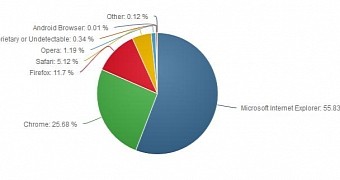Microsoft is making Internet Explorer the second option in Windows 10 before eventually phasing it out completely, but the world doesn’t yet seem to be ready to give up on this browser.
Right now, Internet Explorer is the number one browser on the desktop, and statistics prove that it could remain so even after its public demise in Windows 10.
Basically, with Windows 7 and Windows XP still holding a hefty market share, and not getting the new Edge browser that replaces Internet Explorer, many users would continue running it, so its market share would only decline by a small percentage.
Specifically, Net Applications claims that last month Internet Explorer secured the leading position in browser charts with a share of 55.83 percent, which means that more than 1 in 2 users with a PC relied on Internet Explorer to browse the web.
Chrome second, Firefox third
According to the very same stats, Google Chrome has a share of only 25.68 percent, which means that Internet Explorer has more than double the market share of Google’s own browser.
The third place goes to Mozilla’s Firefox, with a share of 11.70 percent.
Version-wise, Internet Explorer 11 is the world’s number one browser with a share of 25.04 percent, followed by Internet Explorer 8 with 16.05 percent.
Google Chrome 41 takes the third spot with 8.86 percent, while Internet Explorer 9 comes next with 8.10 percent. Chrome 42 and Firefox 37 follow it closely with 7.69 and 6.45 percent, respectively.
Internet Explorer will no longer be the default browser in Windows 10 and Microsoft will replace it with Edge, a new solution that’s designed as a Modern app that can run on smartphones, tablets, and PCs powered by the new operating system. Edge will include personal assistant Cortana, as well as an overhauled UI supposed to make browsing and sharing faster and easier.

 14 DAY TRIAL //
14 DAY TRIAL //